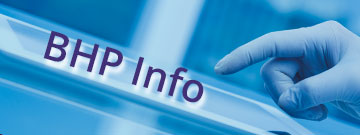Misją Instytutu jest dzialalność naukowo-badawcza prowadząca do nowych rozwiązań technicznych i organizacyjnych użytecznych w kształtowaniu warunków pracy zgodnych z zasadami bezpieczeństwa pracy i ergonomii oraz ustalanie podstaw naukowych do właściwego ukierunkowywania polityki społeczno-ekonomicznej państwa w tym zakresie.
-

Właściwości pożarowe i wybuchowe surowców roślinnych -

Badania palności i wybuchowości -

Pyły zbóż - Podsumowanie -

Pyły zbóż - BIBLIOGRAFIA -

Minimalna temperatura zapłonu warstwy pyłu jako parametr biernej ochrony przeciwwybuchowej -

Warunki i mechanizmy powstawania atmosfer pyłowo-powietrznych -

MTZ warstwy pyłu - rys historyczny -

MTZ warstwy pyłu - metoda oznaczania -

MTZ - Podsumowanie -

MTZ - BIBLIOGRAFIA -

Zagrożenie wybuchem i pożarem - Artykuły
BIBLIOGRAFIA
[1] Eckhoff R.K. Dust explosions in the process industries. Elsevier 2003
[2] Porowski R., Małozięć D. Zagrożenie wybuchem pyłów palnych oraz metody zapobiegania, „Bezpieczeństwo
i Technika Pożarnicza" 2012, 4
[3] Bartknecht W. Explosions - Course, Prevention, Protection. Springer Verlag 1981
[4] Kordylewski W. Spalanie i paliwa. Oficyna Wydawnicza Politechniki Wrocławskiej, wyd. V, 2008
[5] Teodorczyk A. Podstawy modelowania matematycznego wybuchu mieszaniny pyiowo-gazowej. III Międzynarodowa Szkoła Wybuchowości Pyłów Przemysłowych 1987
[6] Law C. K. Combustion physics. Cambridge University 2006
[7] Palmer K.N., Butlin R.N. Dust explosibiiitytests and their application. "Powder Technology" 1972,6,3
[8] PN-EN 50281-2-1, Urządzenia elektryczne do stosowania w obecności pyłów palnych - Część 2-1: Metody badania - Metody oznaczania minimalnej temperatury zapłonu pyłu, 2002
[9] ASTM E2021, Standard Test Method for Hot-Surface Ignition Temperature of Dust Layers, 2013
[10] Lebecki K., Dyduch Z., FibichA.,ŚliżJ. Ignition of a dust layer by a constant heat flux. "Journal of Loss Prevention in the Process Industries" 2003,16
[11] Kim H.M., Hwang C.C. Heating and ignition ofcom-bustible dust layers on a hot surface: Influence of layer shrinkage. "Combustion and Flame" 1996,105
[12] Dyduch Z., Majcher B. Ignition ofa dust layer by a constant heat flux-heat transport in the layer. "Journal of Loss Prevention in the Process Industries" 2006,19
[13] Querol E., Torrent J. G., Bennett D., Gummer J., Fritze J.-P Ignition testsforelectricalandmechanicalequipment subjected to hot surface. "Journal of Loss Prevention in the Process Industries" 2006,19
[14] Janes A., Carson D., Accorsi A., Chaineaux J., Tribouilloy B., Morainvillers D. Correlation between self-ignition of a dust layer on a hot surface and in baskets in an oven. "Journal of Hazardous Materials" 2008,159
[15] Wiśniewski S., Wiśniewski T.S. Wymiana ciepła, WNT 2009
[16] Półka M., Salomonowicz Z., Woliński M., Kukfisz B. Experimental analysis of minimal ignition temperatures of a dust layer and clouds on a heated surface of selected flammable dusts. International Symposium on Safety Science and Technology, 2012
[17] Park H., Rangwala A.S., Dembsey N.A. A means to estimate thermal kinetic parameters of coal dust layer from hot surface ignition test. "Journal of Hazardous Materials" 2009, 168
[18] Park H., Zalosh R. Airflow and oxygen concentration effects in dust layer hot surface ignition temperature tests. 5th International Seminar on Fire and Explosion Hazards, 2007
[19] Joshi K. A., Raghavan V., Rangwala A. S. An experimental study of coal dust ignition in wedge shaped hot plate configurations. "Combustion and Flame" 2012,159
[20] PN-EN 60079-14, Atmosfery wybuchowe - Część 14: Projektowanie, dobór i montaż instalacji elektrycznych, 2013
[21] http://www.ankolab.pl/
[22] Amyotte P R. Some myths and realities about dust explosions. "Process Safety and Environmental Protection" 2014, 92
Podziękowania
Za pomoc w powstaniu publikacji autor pragnie serdecznie podziękować Panu Andrzejowi Kołaczkowskiemu z firmy PPU. ANKO z Warszawy, projektantowi i dostawcy aparatury do badań eksplozymetrycznych i określania parametrów wybuchowości oraz kolegom z Zespołu Laboratoriów Procesów Spalania i Wybuchowości (BW) Centrum Naukowo-Badawczego Ochrony Przeciwpożarowej im. Józefa Tuliszkowskiego w Józefowie.

Ostatnio udostępnione tematy
w BHP-Info:
- INTERGON - ocena ryzyka rozwoju dolegliwości m-s
- MOBBING w pracy
- BHP pracy platformowej
- Symulatory VR w BHP
- Quady w pracy - narażenie kierowcy na drgania
- Montaż w przemyśle lotniczym
- Osłony w meblarstwie
- Praca zdalna przy komputerze
- Kleszcze i borelioza w pracy
- Praca mobilna
- Warunki Pracy w Polsce i w UE 2018
- Zarządzanie BHP wg normy PN-ISO 45001
- Depresja w pracy
- Konflikty w pracy
- SMOG - Ochrona przed SMOGiem
- Zagrożenie wybuchem i pożarem
- Ochrona radiologiczna w rentgenodiagnostyce
- BHP w inteligentnym środowisku pracy 4.0
- Wypadki w szkole
- Wypadki przy pracy rolniczej
- Diabetyk w pracy
- Ocena drabin - wymagania norm (2017)
- Ergonomia stanowisk komputerowych
- Zarządzanie wiekiem pracowników - wiedza i praktyka
- Profilaktyka przewlekłej niewydolności żylnej nóg
- Bezpieczne przenoszenie ładunków
- BHP - Elektrownie wiatrowe
- BHP w służbach mundurowych
- Odzież ostrzegawcza
- Ochrona przed upadkiem z wysokości
- BHP w energetyce słonecznej
- BHP operatora maszyn ręcznych z napędem elektrycznym

